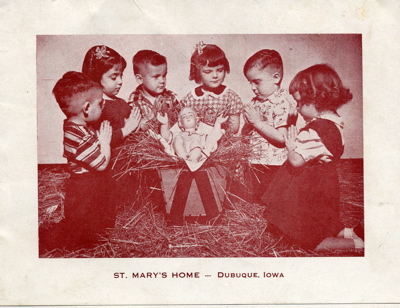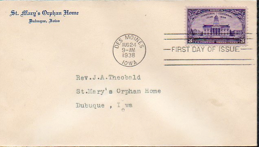Encyclopedia Dubuque
"Encyclopedia Dubuque is the online authority for all things Dubuque, written by the people who know the city best.”
Marshall Cohen—researcher and producer, CNN
Affiliated with the Local History Network of the State Historical Society of Iowa, and the Iowa Museum Association.
ST. MARY'S ORPHAN HOME
ST. MARY'S ORPHAN HOME. The bequests made by Senes and Scholastica Huegel made possible the opening of St. Mary's Orphan Home in December 1878. (1) The Catholic couple left their entire estate to Archbishop John HENNESSY for the construction of a home for orphans. Hennessy asked the SISTERS OF THE THIRD ORDER OF ST. FRANCIS OF THE HOLY FAMILY (OSF) to come to Dubuque to administer the project. (2)
The first building occupied by the home was an old rock structure on the corner of Eighth and White STREETS. This had been constructed as the Holy Trinity Church and school. (3) The home was kept at this site for one year. In 1879 the residence and grounds of J. Duncan, comprising thirty-one acres near LINWOOD CEMETERY, were purchased for seven thousand dollars. This area provided the home's next location. Upon his death, it was found that Archbishop Hennessy left $3,000 to the Sisters of St. Francis for their orphanage. (4)
By 1938 the home, under the supervision of the Archdiocesan Bureau of Catholic Charities, had cared for more than 2,800 children and served an estimated six million meals. Five of the former orphans had become priests and 20 of the girls had entered religious orders. (5)
By the 1960s, following another relocation to Kaufmann Avenue, the focus of the home became one of serving "hard to care for children." Children were brought by their parents or referred by teachers, clergymen, doctors or the courts. The first staff members included Sister Mary Claudette, superintendent; the Rev. Thomas RHOMBERG, chaplain; Ozzie Dolan, program director; and Mrs. Edward Lorenz and all held master's degrees in social work. (6) As staff members were added, all were sent to a university for child welfare work. In January 1960 the staff included ten Sisters and fifteen lay people.
The first physical change was remodeling one of the dormitories into an apartment with living quarters for eight or nine children and their house parent. (7) Here the group lived with one or two children in each bedroom and a living room for working on homework or watching television. There was also an assistant house parent for each family group. These were social science majors attending LORAS COLLEGE or CLARKE COLLEGE who lived at the home. They also provided the house parents days off each week. (8) The six students were employed year round and provided camping and outing activities during the summer. Each resident also had a "big brother" or "big sister" chosen from among college volunteers. Each of these students spent between four and eight hours each week helping their "family member" with homework or taking them shopping. (9)
After 1968 the building on Kaufmann Avenue was known as AREA RESIDENTIAL CARE, INC.
The 1939 Dubuque City Directory through 1948 Dubuque Classified Business Directory listed 905 Davis.
---
Source:
1. "Mass to Commemorate 60th Orphan Home Anniversary," Telegraph Herald, April 24, 1938, p. 2
2. Ibid.
3. Ibid.
4. Gallagher, Mary Kevin. Seed/Harvest: A History of the Archdiocese of Dubuque, Dubuque: Archdiocese of Dubuque Press, 1967, p.45
5. Ibid.
6. Williams, Vera. "St. Mary's Building Lives," Telegraph Herald, January 1, 1960, p. 11
7. Ibid.
8. Ibid.
9. Ibid.




